|
|
Petrarch

|
|
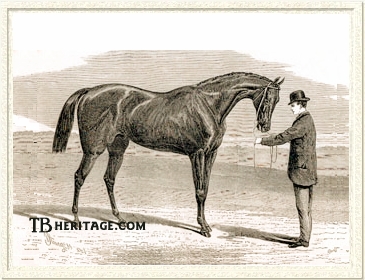 |
|
|
Petrarch was a successful, if erratic, racehorse that won two classic races and the Ascot Gold Cup. He was at stud when stallions such as Bend Or, Galopin, and the seven-time leading sire Hermit were turning out winners, and, while not fashionable -- possibly due to his reputation for fragility -- he still got four classic winners, three in England and one in France, all of them fillies. His son, The Bard, was a successful stallion in France, another son, Hackler, was several times leading sire in Ireland, and led the sire's list of jumpers for seven years, and a daughter was dam of of the two-time leading American sire Meddler.
Petrarch was foaled in 1873. He was a rich bay colt by Lord Clifden, bred by Mr. Gosden at his farm near Midhurst. His dam, Laura, was sired by Derby winner Orlando, who in turn was sired by classic winner and leading sire Touchstone. Laura was foaled in 1860, and by the time of her birth, her sire Orlando had been responsible for classic winners Teddington, Fazzoletto, Imperieuse, and Fitzroland. The dam of Laura was Torment, a daughter of Ascot Gold Cup winner Alarm from a mare by Glencoe. In addition to Laura, Torment had produced Oaks victress Tormentor.
Laura was bred by Mr. Greville at the Hampton Court paddocks and sold at the Hampton Court yearling sale for 260 guineas to Henry Padwick. She was well enough tried to win the Zetland Stakes in her racecourse debut. She failed to win again at age two in three subsequent starts, and at three, she won the March Stakes. Afterwards, she was acquired by Sir John Astley. For her new owner, Laura raced a few more times. Unfortunately, she broke a blood vessel in training and the rest of her career was compromised. Astley initially desired to turn the filly out to pasture to see if rest could rehabilitate her. Plans changed when a Mr. Gosden, visiting the stableyard, took a liking to the filly and offered f25 for her. For Gosden, Laura proved a treasure.
At Gosden's small, but meticulously kept farm, Laura spent her entire broodmare career, dying there after foaling in 1881. For Gosden, she produced Proto-Martyr, a winner of the Bentinck Memorial Stakes; Lemnos, winner of the Champagne Stakes and two runnings of the Biennial at Ascot; and Fraulein, a winner of several stakes, including a score over classic-winning filly Marie Stuart in the Doncaster Cup. Petrarch was her ninth foal. Several years after producing Petrarch, Laura became the dam of Craven Stakes winner Laureate.
Despite the small size of his breeding operation, Gosden got his mares to some of the more renowned stallions around, including St. Albans, Rosicrucian, and Lord Clifden. The latter, the sire of Petrarch, was a son of St. Leger winner Newminster. Like his sire, Lord Clifden captured the St. Leger, and was second to Macaroni in the Derby of 1863. He became a successful stallion, his major offspring before Petrarch including St. Leger winners Hawthornden and Wenlock. During his stud career, he also sired multiple cup winner and important sire Hampton and Oaks and St. Leger victress Jannette. Both Petrarch's paternal grandsire Newminster and maternal grandsire Orlando were sired by Touchstone, making Petrarch inbred 3x3 to that classic winner and champion stallion.
Petrarch on the Turf
From birth Petrarch was a delicate individual, but seemed to belie his frail constitution with his extraordinarily handsome appearance. Alexander Scott, author of Turf Memories of Sixty Years, remarked, "Whenever I am asked to give my opinion of the grandest looking Thoroughbred of the past sixty years, I always declare unhesitatingly for Petrarch." Trainer Robert Peck was heard to say of Petrarch the first time he ever saw him, "What a beautiful horse!"
Petrarch did not make his first start until the fall of his two-year-old year. Gosden picked an ambitious spot for his colt to make his debut, for the race he chose was the prestigious Middle Park Plate. In a mammoth field of thirty runners, Petrarch won easily and authoritatively by four lengths. Among the beaten were the Hungarian-bred colt Kisber and Kaleidoscope, owned by Lord Dupplin.
So impressed with Petrarch was Lord Dupplin, he approached Gosden about the possibility of purchasing the colt. Petrarch performed well enough in a trial before Lord Dupplin and his trainer John Dawson he wound up being purchased for the weighty sum of £10,000.
Petrarch was not seen out again until spring, when he came out for the Two Thousand Guineas. He had been beaten by stablemate Kaleidoscope in a home trial, and consequently went to Newmarket as the second fiddle to Kaleidoscope, who started favorite at 3-1. No one told Petrarch he was the underdog, as he won easily by three lengths from Julius Caesar, with Kaleidoscope third.
Started next for the Derby, Petrarch ran an unexpectedly poor race, surrendering without a fight to the onrush of Kisber, fading to finish fourth. The cause of his lackluster performance was intermittent kidney trouble, which flared up between the Guineas and Derby, leaving the colt far from his best. Petrarch recovered well enough to capture the Prince of Wales's Stakes at the Royal Ascot meeting, but then fared poorly in two subsequent starts, finishing last of four in the Biennial Stakes and next to last in a four horse field for the Triennial Stakes. This necessitated a long rest for Lord Dupplin's delicate colt.
Petrarch regained his health and strength and was in good enough form to contest the St. Leger at Doncaster in September. He ran a hard-fought race to defeat Wild Tommy by a neck, with Derby winner Kisber unplaced. That was all for Petrarch as a three-year-old.
During the winter, he was sold to Lord Lonsdale, who lost no time in starting Petrarch for the Lincolnshire Handicap. In a field of 32 horses and under 125 pounds, Petrarch failed, finishing unplaced to Footsteps, in receipt of 25 pounds. Petrarch was regrouped, and rattled off three sparkling performances. He enjoyed a walk-over at Newmarket, took the High Level Handicap at Epsom, then easily took the Ascot Gold Cup. He finished only a head behind Snail in the Liverpool Summer Cup, and then suffered a recurrence of his bad form, running unplaced to Hampton in the Goodwood Cup. Petrarch was not seen under colors again that season.
As a five-year-old, Petrarch was out only three times. His first effort was an unplaced run at Epsom. He came out as Ascot to capture the Rous Memorial Stakes. Sold after this race to Lord Calthorpe, Petrarch made his final start in the Champion Stakes at Newmarket in the autumn. He was unplaced in the race won by that season's Oaks and St. Leger heroine Jannette, who had a neck margin over the previous year's Derby winner Silvio. Former stablemate Kaleidoscope was a distant third.
During his four seasons on the track, Petrarch contested sixteen races, won exactly half of them, was second once, once third, and six times unplaced. Some criticized his record as spotty, given the high number of times he failed to notch a spot in the top three. His jockeys never criticized his courage, all of them describing him as game. The blame lay with his kidney trouble, which plagued him throughout his career, his fragile health making it exceedingly difficult for trainer John Dawson to keep him at his fittest. Dawson also trained Galopin, and when asked to compare the two, replied, "Petrarch was a good horse, a very good horse, and there was only just this difference between him and Galopin: I knew exactly how good Petrarch was, but I could never find out what was Galopin's limit." Galopin was a strong, brilliant performer, only once defeated in a two year and eleven race career. That Petrarch was able to compete at the highest levels of racing over four years while suffering from a recurring kidney ailment is testament enough to his courage and quality.
Petrarch in the Stud
Petrarch was retired to stud at the Hampton Court Stud, joining Springfield among the stallions in residence there. Petrarch's initial stud fee was 100 guineas, the same fee as Springfield. Later, he stood several seasons at Lanwades Stud at Kennett, near Newmarket. Throughout his career, Petrarch was noted as a sire of precocious stock. Two of his best years were 1883, during which Petrarch had nine winners from 32 total foals, all nine being two-year-olds, and 1889, during which he had ten two-year-old winners.
Petrarch was the sire of four classic winners, and all were fillies.
The first, born in 1881, was the bay filly BUSYBODY. This filly was bred by Evelyn Boscawen, sixth Viscount Falmouth at his Mereworth Castle Stud in Kent. Busybody was as exquisitely bred as any filly could be. Her dam, Spinaway, was a daughter of two classic winners, Derby winner Macaroni and Oaks heroine Queen Bertha. She was a half-sister to Wheel of Fortune, victress in the One Thousand Guineas and Oaks.
|
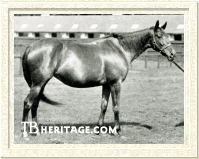
Busybody
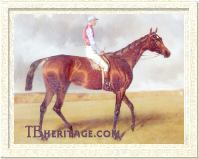
Miss Jummy
| |
Busybody raced for Lord Falmouth as a two-year-old when she won the Middle Park Plate, Rous Memorial at Newmarket and Great Challenge Stakes. It was Lord Falmouth's bad luck to decide to retire from racing during the winter of 1883-1884. Early in 1884, he held a dispersal of his stock. The Sterling colt Harvester was sold to Sir John Willoughby and went on that spring to take the Derby in a dead-heat with St. Gatien. Busybody was acquired by young Scotsman George Alexander Baird, and for him went on to capture the One Thousand Guineas and Oaks. Busybody raced no more after the Oaks.
As a broodmare she produced the St. Gatien colt Meddler, undefeated in three starts as a juvenile. Baird's untimely death rendered void all of Meddler's subsequent stakes engagements. The horse was sold to American interests and sent to America for stud duty. In the United States, Meddler led the American general sire list twice and was sire of several standout performers, including Belmont Stakes victress Tanya, and was sire of the dams of Epsom Derby winner Durbar II, and American champions Johren, Untidy, and Grey Lag. Busybody's daughter Bass, by Saraband, became the second dam of the Verwood colt Le Traquet, winner of the French Two Thousand Guineas in 1921.
|
Petrarch boasted two classic caliber fillies from his 1883 foal crop, as well as a classic-placed colt. MISS JUMMY, out of Lady Portland, by The Primate, was a bay filly owned by the Duke of Hamilton and trained by Richard Marsh. She proved a good two-year-old, winning the Buckenham, Rutland, and Clearwell Stakes. At three, her victories included the One Thousand Guineas, Oaks, Nassau Stakes, and Park Hill Stakes. At stud, she bred several foals, but nothing which possessed her top class ability.
PRESTA was a French-bred bay daughter of Petrarch out of Pristina, by Dollar. She was best at age three, when her record boasted a victory in the Prix de Diane. Like Miss Jummy, she failed to produce anything approaching her own class.
THE BARD (1883, out of Magdalene by Syrian) was was a stylish little chestnut -- almost roan -- colt with the Birdcatcher ticking, standing barely 15 hands. He was not a classic winner, but had he been foaled in any other year, he very well may have been. It was The Bard's misfortune to come along in the same foal crop as the Duke of Westminster's Bend Or colt, Ormonde. For owners Robert Peck and Owen Williams, he came to hand early and stayed good for a long period of time. He was unbeaten in sixteen races as a two-year-old, a string of wins that held as a record for years.
THE BARD did not make his three-year-old debut until the Epsom Derby. Against the glamorous Ormonde, the pony-sized The Bard was definitely an underdog. But he was courageous. Coming into the straight, the race was between these two. The Bard, under terrific urging from rider Charlie Wood, gave all he had, but eventually gave way to Ormonde, guided by Fred Archer. Ormonde drew clear to win by a length and a half. Owner Peck had seen enough of Ormonde, and left the St. Leger for Ormonde, who won to become an unbeaten Triple Crown champion. The Bard, without the specter of Ormonde, won six of his remaining races at three, his only other loss being a second to Riversdale in the Manchester Cup while receiving 31 pounds. During the season he captured the Goodwood and Doncaster Cups.
|
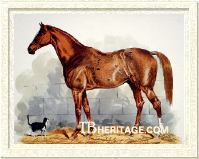
The Bard
| |
THE BARD got a certain measure of revenge on Ormonde, for he went on to become a more successful sire, in the short term. Ormonde's stud career in England yielded the fine performers Orme and Goldfinch. Orme went on to sire three English classic winners, including Flying Fox, a highly influential sire in France through his sons Ajax and Teddy. The Bard, on the other hand, spent the majority of his stud career in France, led the French sires list twice -- in 1894 and 1901 -- and sired six French classic winners, including Annita (Prix de Diane); Saxon (Prix du Jockey Club); Tilly and Calceolaire, winners each of the Poule d'Essai des Pouliches (French One Thousand Guineas); and Launay and Indian Chief, each winners of the Poule d'Essai des Poulains (French Two Thousand Guineas). But The Bard left no lasting sire line. |
| Petrarch's final classic winner was the filly THROSTLE. This bay filly was bred by Lord Alington. Her dam, the Scottish Chief mare Thistle, had two excellent performers on the track in 1891, the year Throstle was born. Her son Common was a winner of the Two Thousand Guineas and would complete a sweep of the Triple Crown, and son Goldfinch was a speedy winner of the Biennial Stakes at Kempton Park and the New Stakes at Ascot.
|
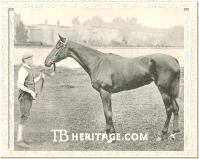
Throstle
| |
THROSTLE was foaled at the Duke of Portland's Welbeck Abbey Stud, where Lord Alington boarded his mares. Like her sire, Throstle suffered from physical infirmities which plagued her throughout her career. At birth, the filly was nearly blind from a film covering her eyes. For three months she lived with this handicap, and serious thought was given to having her put down. Her condition then improved significantly, but still, Lord Alington seemingly had no desire to persevere with her and gave her away. Fortunately for Throstle, the person to whom she was given failed to collect her and she remained in the care of trainer John Porter at Kingsclere. The trainer had his hands full, for in addition to her troubled eyesight, Throstle had a tendency to pop splints. |
At two, THROSTLE made only three starts, and her best showing was a second in the Chesterfield Stakes. At three, she made no mark in the One Thousand Guineas, and Lord Alington decided against sending her to Epsom for the Oaks. She was given a chance in the Coronation Stakes at Ascot and won narrowly, defeating One Thousand Guineas winner Amiable. She then ran a creditable fourth in the Eclipse Stakes, behind Isinglass, Ladas, and Ravensbury. She followed that performance with a victory in the Nassau Stakes at Goodwood. Lord Alington decided to let her have a go in the St. Leger. Throstle ran in last place for a great portion of the race, nearly clipped heels with Ladas as she moved into contention, and had to be pulled sharply to avoid going down. When clear, she was set down and ridden out by Mornington Cannon to prevail by three-quarters of a length from Ladas, with Amiable a further length back in third. In defeating Ladas, she denied Prime Minister Lord Rosebery's colt a sweep of the Triple Crown.
In the Jockey Club Stakes at Newmarket, THROSTLE bolted off the course before a half mile had been run. It was theorized that Throstle's sight still bothered her and the open expanse of Newmarket's course bewildered her, for on courses confined by rails, she ran quite well.
As a broodmare, THROSTLE produced the colt Missel Thrush to the cover of Orme. Missel Thrush was not a top class performer, but was the sire of Thrush, a winner of the July Cup and an important sire. Thrush begot Jackdaw, sire of the popular stayer Brown Jack as well as Grand National winners Grakle and Kellsboro' Jack. Another son of Jackdaw, Jackdaw of Rheims, sired two winners of the Irish Grand National.
Petrarch was the sire of several other good stakes winners. SYMPHONY, a filly out of Bowstring, by Tom Bowline, was owned by Lord Calthorpe. She was victorious in a Triennial Stakes at Ascot. FLORENTINE, out of Hawthorndale, by Kettledrum, was a chestnut colt foaled in 1884. His major victory came in the St. James's Palace Stakes at Ascot. PETER FLOWER, out of Florida, by Glendale, was born in 1888. He managed a third to Common in the Two Thousand Guineas Stakes of 1891. Peter Flower was not a stud success, but did have a son, Lupin, who sired some winners in New Zealand. LAUREATE II, out of Macaria, by Macaroni, was a winner of the Royal Hunt Cup and the Cambridgeshire Handicap.
|
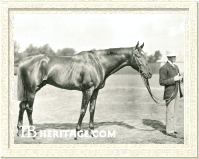
The Lombard
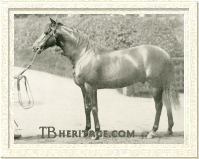
Lactantius
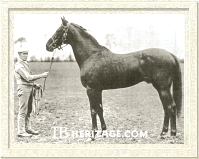
Hackler
| |
Petrarch's son THE LOMBARD, out of the Sterling mare Wealth, was a foal of 1892 and counted the Rous Memorial Stakes as his major racecourse accomplishment and was a sire in Hungary.
Another son, LACTANTIUS (1887) bred from the Macaroni daughter Koumiss at the Rothschild Southcourt Stud, was second to Semolina in Lincoln's Brocklesby Stakes, to Overveen in Epsom's Westminster Stakes, and to his half-sister Heresey in Newmarket's Spring Stakes, was third to Signorina and Alloway in the Two Year Old stakes at Kempton Park, and won Esher's Great Kingston Stakes. At age three he won Northampton's Spencer Stakes, a plate at Sandown, and a handicap at Ascot, took a walk-over for a handicap at Northampton, and dead-heated with Middlesex in the Chippenham Stakes. At age four he ran second in Northampton's Earl Spencer plate, and was third in the Wokingham Stakes. He retired to Southampton where he got some fast juveniles, including Gay Lothair and Allegro.
HACKLER not only was a good stakes-winning son of Petrarch, but his finest siring son, as well, becoming a leading sire of flat racers in Ireland and a leading sire of jumpers in the U.K. seven times. A foal of 1887, Hackler was a bay out of Hackness, by Albert Victor. He was bred by Robert Peck at Howbury Hall, Bedfordshire and purchased for racing by George Alexander Baird.
On the track, HACKLER'S resume boasted a win in the Burwell Stakes, capturing that race as a three-year-old. In 1891, he was consigned by Baird to the Newmarket December sale. He was purchased by James Daly of Liffey Bank, Dublin. Between 1898 and 1906 Hackler was one of the most successful stallions based in Ireland, and he proved prolific as both a sire of runners on the flat and over jumps. |
On the flat, HACKLER sired Irish Oaks victress Sabine Queen, in turn dam of Irish Oaks winner Queen of Peace; St. Brendan, winner of the Irish Derby; and Fredith, a winner of the Irish Oaks. Other good runners on the flat for Hackler included stakes winner Hornet, later dam of the top sprinter Hornet's Beauty; Prince of Naples; Lalla Rookh; and Hackler's Pride, a filly who was victorious in the Rous Memorial Stakes at Ascot and the Cambridgeshire Stakes. Lalla Rookh became the dam of the brilliantly fast filly Ayn Hali, in turn dam of the speedy stakes winner Sir Cosmo. Sir Cosmo sired, among others, the filly Knight's Daughter, an American Broodmare of the Year and dam of American champion and Horse of the Year Round Table.
Jumpers sired by HACKLER included Grand National winners Jenkinstown, winner of the Aintree event in 1901 and Covertcoat, victorious in 1906. Little Hack II, a tough and courageous mare with a career of astounding longevity, was a dual winner of the Irish Grand National.
Petrarch had several other sons who were given opportunities at stud, including Lemnos and the aforementioned Laureate II. They sired a good number of winners, but none were able to perpetuate Petrarch's male line. His daughters fared better, for he had several influential ones in addition to Busybody.
MARGARINE was a filly foaled in 1887, out of Margarita, by The Duke. Her victories on the racecourse included the important Champagne Stakes at Doncaster and the Prince of Wales's Plate. She proved an admirable broodmare. She produced Butter, by Springfield, and that colt went on to win the Doncaster Stakes and Biennial Stakes at Ascot. Her son, St. Martin, by St. Frusquin, was multiple stakes-placed. But it was her daughter by St. Frusquin, the splendid Quintessence, for whom she is most remembered. Quintessence was unbeaten, her victories including the One Thousand Guineas, Newmarket Oaks, and Park Hill Stakes. At stud, Quintessence produced the Radium colts Paragon and Clarissimus. The former was a winner of the Jubilee, Duke of York, and City and Suburban Handicaps. Clarissimus a chestnut foaled in 1913, was a winner of the Clearwell Stakes at two, and the Two Thousand Guineas and Champion Stakes at three. At stud, Clarissimus made a huge impact as a sire of broodmares. Daughters of Clarissimus produced the likes of Donatello II, Brantome, and Pharis. Boudoir II, a daughter of Mahmoud from a Clarissimus mare, became influential in American breeding through such descendants as Graustark, His Majesty, and Majestic Prince.
FILOMENA, foaled in 1888, was a full sister to Florentine. Filomena became a successful broodmare for French breeding. To the cover of Winkfield's Pride, she produced in 1900 the chestnut colt Quo Vadis. On the track, Quo Vadis was victorious in the Grand Prix de Paris and Prix Noailles, second to Ex Voto in the Prix du Jockey Club, and third to Caius in the Prix Lupin. At the end of his three-year-old season, Quo Vadis was sold for stud duty to the Russian Imperial Stud. Filomena produced Prix Royal Oak winner Fer from a union with St. Serf.
CORRIE DHU, bay filly foaled in 1887, was imported into Argentina as a two-year-old in 1889 by Santiago Luro. Her daughter, Fedra, by Gay Hermit, captured the Gran Premio Polla de Potrancas, Argentina's One Thousand Guineas.
Two unraced daughters of Petrarch proved significant. LAURETTA was a bay filly foaled in 1883 from the Camerino mare Ambuscade. Lauretta became the dam of Doris, a plain, almost pony-sized brown filly by Loved One. Doris proved not much more than selling plater on the racecourse, but at stud, it was a different story. As a broodmare at Jack Barnato Joel's Childwickbury Stud, Doris foaled ten winners. Her son, Sunstar, was a winner of the Two Thousand Guineas and Derby in 1911, and daughter Princess Dorrie was victress in the One Thousand Guineas and Oaks in 1914. White Star, a full brother to Sunstar, was a brilliant two-year-old in 1911, taking the Woodcote Stakes, July Stakes, Champagne Stakes, and Dewhurst Plate. Another full sibling to Sunstar was the filly Bright, second to Snow Marten in the 1915 Oaks and third to Vaucluse in the One Thousand Guineas.
COMIC SONG, one year younger than Lauretta, was produced from Frivolity, a daughter of Macaroni and the influential mare Miss Agnes. She came into the possession of the Duke of Portland, who bred the St. Simon filly Concertina from her. Concertina was of no particular fame on the racecourse, but was a prolific producer. Concertina's most notable offspring was the Spearmint filly Plucky Liege, a nice enough sprinter at two but destined for greater things as the dam of major sires Sir Gallahad III, Bull Dog, Admiral Drake, and Bois Roussel, and influential daughters Marguerite de Valois and Noor Jahan.
Petrarch was sold to French interests after the end of the 1893 breeding season, and spent a few years in there prior to his death before the close of the century.
--Liz Martiniak
|
|
|
|

